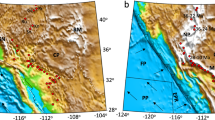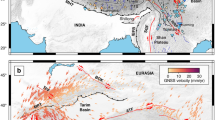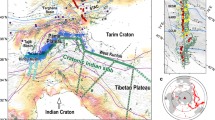Abstract
THE analogue model1–4 of plane indentation5 is applied qualitatively here to the proposed collision6 of the Slave craton (last major deformation ∼ 2,500 Myr ago) and the western Churchill craton (last major deformation ∼ 1,740 Myr ago) of the Canadian Shield. The model successfully predicts several large-scale deformational features of the collision zone. McKenzie1 has drawn an analogy between the collision of the African plate (Arabian shield) with the Eurasian plate and the impaction of a hard die on a soft piece of metal. He concluded that when salients of an approaching continent meet an Andean-type margin of another continent, further lithospheric consumption is not possible due to the buoyancy of continental crust1,7 and either the crust of the underthrust continent is thickened, or two or more small plates (such as the Turkish, Aegean and Iranian plates) are formed and are pushed aside to permit further convergence, or both processes occur1.
This is a preview of subscription content, access via your institution
Access options
Subscribe to this journal
Receive 51 print issues and online access
$199.00 per year
only $3.90 per issue
Buy this article
- Purchase on Springer Link
- Instant access to full article PDF
Prices may be subject to local taxes which are calculated during checkout
Similar content being viewed by others
References
McKenzie, D. Geophys. J. R. astr. Soc. 30, 109–185 (1972).
Molnar, P. & Tapponnier, P. Science 189, 419–426 (1975).
Tapponnier, P. & Molnar, P. Nature 264, 319–324 (1976).
Molnar, P. & Tapponnier, P. Geology 5, 212–216 (1977).
Hill, R. The Mathematical Theory of Plasticity (Oxford University Press, Oxford, 1950).
Gibb, R. A. & Thomas, M. D. Tectonophysics 38, 211–222 (1977).
McKenzie, D. P. Geophys. J. R. astr. Soc. 18, 1–32 (1969).
Hoffman, P. F., Bell, I. R., Hildebrand, R. S. & Thorstad, L. Pap. geol. Surv. Can. 77-1 A, 117–129 (1977).
Wright, G. M. Mem. geol. Surv. Can. 350 (1967).
Davidson, A. Spec. Pap. geol. Ass. Can. 11, 381–433 (1972).
McGlynn, J. C. Econ. Geol. Rep. geol. Surv. Can. 1, 71–76 (1970).
Fraser, J. A. Pap. geol. Surv. Can. 63–40 (1964).
Thomas, M. D., Gibb, R. A. & Quince, J. R. Can. J. Earth Sci. 13, 1244–1250 (1976).
Fraser, J. A. Pap. geol. Surv. Can. 71–38 (1972).
Byers, A. R. Spec. Publ. R. Soc. Can. 4, 40–59 (1962).
Reinhardt, E. W. Pap. geol. Surv. Can. 69–21 (1969).
Burwash, R. A. & Baadsgaard, H. Spec. Publ. R. Soc. Can. 4, 22–29 (1962).
Reinhardt, E. W. Pap. geol. Surv. Can. 72–25 (1972).
Campbell, F. H. A. & Cecile, M. P. Pap. geol. Surv. Can. 76-1 A, 369–377 (1976).
Hoffman, P. Phil. Trans. R. Soc. Lond. A 273, 547–581 (1973).
Gibb, R. A. & Thomas, M. D. Nature 262, 199–200 (1976).
Author information
Authors and Affiliations
Rights and permissions
About this article
Cite this article
GIBB, R. Slave–Churchill collision tectonics. Nature 271, 50–52 (1978). https://doi.org/10.1038/271050a0
Received:
Accepted:
Published:
Issue Date:
DOI: https://doi.org/10.1038/271050a0
This article is cited by
Comments
By submitting a comment you agree to abide by our Terms and Community Guidelines. If you find something abusive or that does not comply with our terms or guidelines please flag it as inappropriate.



